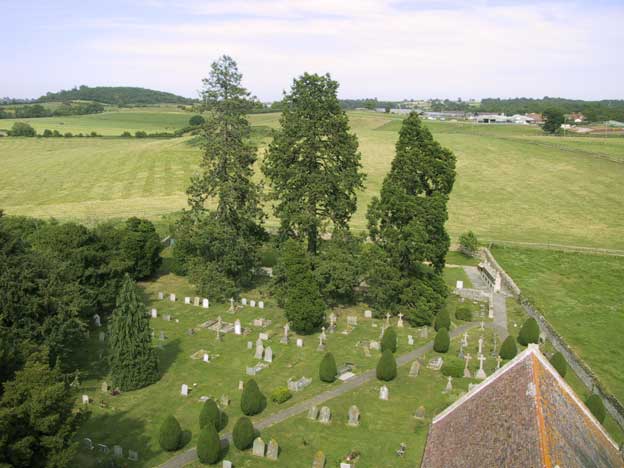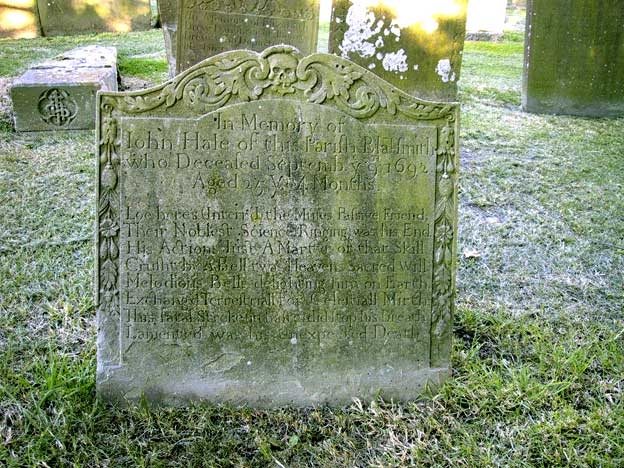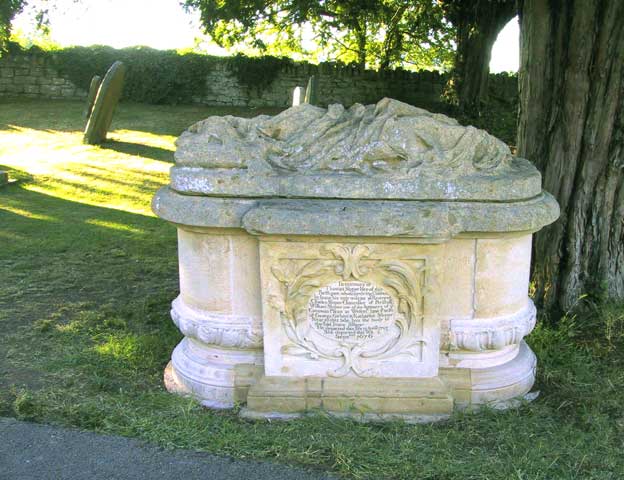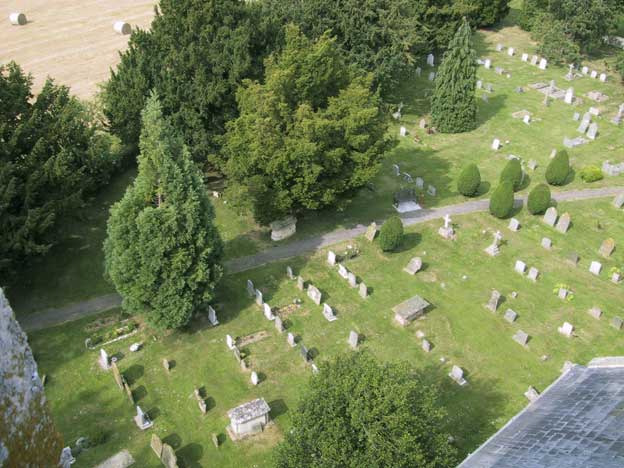Most of the wall surrounding the churchyard was built at the end of the 18th century. An entry in the churchwardens’ accounts records the purchase in 1797 of 12 tons of stone from the village quarry – for the wall, together with 30 gallons of drink for the workman!
 Lying to the north of the church are the oldest group of headstones, dating from the 17th century. They are easily recognised, as they are thick pale Cotswold limestone with a heavy carved hood, and include one with what appears to be the face of the Green Man. Before the end of the century green Forest of Dean sandstone was also used, which produced a thinner stone with more elegant script than was possible with the local blue Lias ‘mudstone’. These three stone types were generally used until the Victorians introduced marble and other stone from further afield.
Lying to the north of the church are the oldest group of headstones, dating from the 17th century. They are easily recognised, as they are thick pale Cotswold limestone with a heavy carved hood, and include one with what appears to be the face of the Green Man. Before the end of the century green Forest of Dean sandstone was also used, which produced a thinner stone with more elegant script than was possible with the local blue Lias ‘mudstone’. These three stone types were generally used until the Victorians introduced marble and other stone from further afield.
 One of the most interesting Hartpury stones, surmounted by the death’s head, records the death of John Hale – blacksmith, who was crushed by a bell in 1692:
One of the most interesting Hartpury stones, surmounted by the death’s head, records the death of John Hale – blacksmith, who was crushed by a bell in 1692:
‘Loe here’s interr’d the muses passive friend
Their noblest science – ringing was his end
His actions just, a martyr of that skill
Crusht by a bell ’twas Heavens sacred will
Melodious bells delighting him on earth
Exchanged terrestriall for celestiall mirth
This fatal stroke in haste did stop his breath
Lamented was his unexpected death’
At the far end of the churchyard is the unique Bee Shelter, moved to the churchyard in 2002.
The southerly churchyard path passes the grave of Evan Williams, father of the wife of the real tailor on whom Beatrix Potter based her well know Tailor of Gloucester’s story – the waistcoat really was mysteriously completed while the tailor was ill in bed!
The Sloper memorial
Lying in the shade of an overhanging yew, to the north of the Church there is a fine ‘listed’ table tomb, which records that Thomas Sloper died on 13th April 1703. Thomas was a Clerk of the Court of Kings Bench in Westminster. In 1657 he married Joane Beale, whose family are recorded as living in Corsend, Hartpury for at least the previous 100 years. The baroque chest tomb with D shaped ends dates from the early 18th century, but what is more remarkable is the stone effigy that surmounts it. Dressed in cerements or grave clothes of exuberant and deeply carved drapery, the figure is assumed to be that of Joane, his wife, who died in 1676. It is modelled on the reclining effigy so often found on interior monuments but rarely seen outside.
Thomas was a Clerk of the Court of Kings Bench in Westminster. In 1657 he married Joane Beale, whose family are recorded as living in Corsend, Hartpury for at least the previous 100 years. The baroque chest tomb with D shaped ends dates from the early 18th century, but what is more remarkable is the stone effigy that surmounts it. Dressed in cerements or grave clothes of exuberant and deeply carved drapery, the figure is assumed to be that of Joane, his wife, who died in 1676. It is modelled on the reclining effigy so often found on interior monuments but rarely seen outside.
If this is correct then the 17th century effigy must originally have lain elsewhere and then been moved onto her husband’s tomb at a later date. This would explain the rarity of a 17th century effigy lying outside the church building. Its preservation after 300 years, even in its present worn condition is amazing and can probably be attributed to the protection provided by the old yew tree. The tomb was erected by Charles Sloper, who became Chancellor of the diocese of Bristol.

